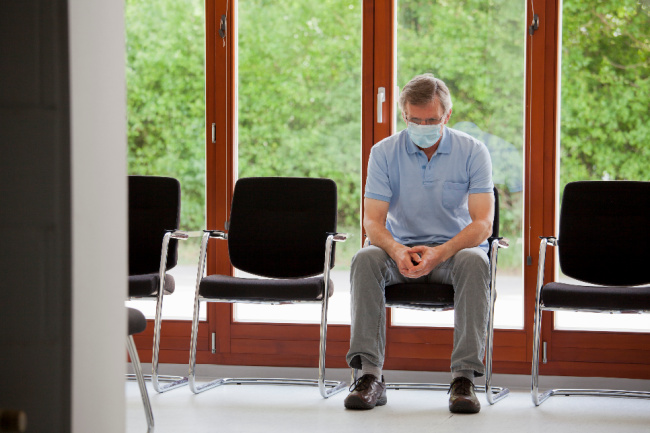Prostate Cancer: Study Investigates Surgery Vs. Delayed Treatment

When men make prostate cancer treatment decisions, they need to weigh the pros and cons of their options. For those considering surgery, new research compares this approach with two others: watchful waiting and active monitoring.
Surgical removal of the prostate gland is called radical prostatectomy. It is a common treatment for men with localized prostate cancer. (Localized means that cancer cells have not spread outside the prostate gland itself.)
However, prostatectomy has its drawbacks. Because the prostate is surrounded by nerves that affect erections, many men have erectile dysfunction (ED) afterward, and it can take time for erections to recover. Urinary incontinence is another frequent complication of prostatectomy.
There might be other options to consider, however. One is watchful waiting. With this approach, men don’t have treatment right away. When they do, the treatment goal is to manage the complications of cancer, not cure the cancer.
Another option is active monitoring (sometimes called active surveillance.) In this case, men don’t have treatment at first, but their symptoms are monitored regularly. When the cancer becomes more concerning, then treatment begins with the goal of curing it.
Is there an advantage to delaying treatment? Prostate cancer tends to grow slowly, so waiting to have treatment can postpone side effects.
The new study, published by the Cochrane Library, investigated all of these approaches. Researchers analyzed four studies including 2,635 men overall.
Three of the studies compared radical prostatectomy with watchful waiting. After analyzing 29 years of follow-up data, researchers determined that men who undergo surgery “probably” have a lower risk of dying from any cause or from prostate cancer itself. They may also be at reduced risk for prostate cancer becoming more aggressive and spreading outside the prostate.
Patients who had surgery tended to have more issues with erections and incontinence. But after twelve years, patients who had either treatment reported high quality of life levels.
The one study comparing prostatectomy with active monitoring found few differences in the risk of dying from any cause or from prostate cancer in 10 years of follow up. The changes of cancer worsening and spreading were probably less for men having surgery, and quality of life was similar for all the men. However, as with watchful waiting, incontinence and ED were more common in men who had had a prostatectomy.
“Based on long-term follow-up, [radical prostatectomy] compared with [watchful waiting] probably results in substantially improved oncological outcomes in men with localised prostate cancer but also markedly increases rates of urinary incontinence and erectile dysfunction,” the authors wrote.
“Compared to [active monitoring], based on follow-up to 10 years, [radical prostatectomy] probably has similar outcomes with regard to overall and disease-specific survival yet probably reduces the risks of disease progression and metastatic disease,” they added, noting again that erections and urinary function were likely to be impaired for men having surgery.
Resources
Cochrane Library
Vernooij, Robin W.M., et al.
“Radical prostatectomy versus deferred treatment for localised prostate cancer”
(Abstract and plain language summary. Published: June 4, 2020)
https://www.cochranelibrary.com/cdsr/doi/10.1002/14651858.CD006590.pub3/full
Reuters Health Information via Medscape
Larkin, Marilynn
“Radical Prostatectomy Curbs Cancer Risks but Ups Adverse Events Compared With Waiting, Monitoring”
(July 1, 2020)
You may also be interested in...
Other Popular Articles

What Is the Average Penis Size?
If you have ever wondered how your penis compares to others in terms of size, you are not alone. Many men are curious to know how their penises stack up compared to the average. Unfortunately, general curiosity can sometimes give way to full-on obsession and anxiety about penis size. This can be an unhealthy and often unnecessary fixation, especially because most men who think their penises are too small have perfectly normal-sized penises.

What Is Jelqing, and Does It Actually Work?
The term “jelqing” refers to a set of penis stretching exercises that some believe can make the penis bigger. Although the practice has gained attention and popularity in blogs and internet forums in recent years, there is no scientific evidence that it is an effective way to permanently increase the size of one’s penis. In fact, in some cases, jelqing may actually cause damage to the penis, so it is a good idea to get all the facts before setting off to try it.

What Is Sensate Focus and How Does It Work?
Sensate focus is a technique used to improve intimacy and communication between partners around sex, reduce sexual performance anxiety, and shift away from ingrained, goal-oriented sexual patterns that may not be serving a couple.

Can Sex Reduce Menstrual Cramps?
The SMSNA periodically receives and publishes ‘guest editorials.’ The current article was submitted by Mia Barnes, a freelance writer and researcher who specializes in women's health, wellness, and healthy living. She is the Founder and Editor-in-Chief of Body+Mind Magazine.
Having sex while you experience menstrual cramps is healthy and can provide significant benefits. While it might not be the first activity that comes to mind when your PMS or period cramping begins, many people enjoy sex to reduce menstrual cramps, experience increased pleasure and benefit from other advantages. Learn more about having sex while menstrual cramps are happening and how it can help your body.

How Long Does It Take the Average Man to Ejaculate?
On average, it takes a man between 5 to 7 minutes to orgasm and ejaculate during sexual intercourse.

The Effect of Regular Aerobic Exercise on Erectile Function
Erectile dysfunction (ED) is the inability to achieve or maintain an erection sufficient for satisfactory sexual activity. As men get older, their erectile functioning may naturally decline due to changes in testosterone levels, cardiovascular functioning, and the potential development of other chronic medical conditions that become more common with age.
You are prohibited from using or uploading content you accessed through this website into external applications, bots, software, or websites, including those using artificial intelligence technologies and infrastructure, including deep learning, machine learning and large language models and generative AI.

